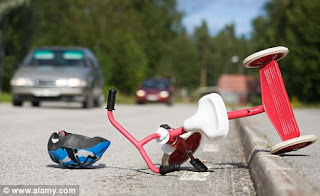The government only records accident data where there are personal injuries. There are several sites that map this government accident data. You might like to try this one http://www.crashmap.co.uk/
From my own experience there have been 4 accidents over the last 5 or 6 years just on the stretch of Station Road between Crown Hill Close and Higham Lane. Only one of these (thankfully it was not more) resulted in a recorded personal injury and is shown on the crashmap dataset.
I have been looking into the costs associated with these injuries. Unfortunately the DfT appraisal tool does not contain a model specifically for 20 mph schemes in villages (just towns). However it does quote an average cost associated with injuries. These costs say a serious injury costs £206,791 and a slight injury £21,556. So this gives a total cost of injuries in Stoke Golding of £508,000 over 7 years (around £72,000 pa). A fatality (heaven forbid) costs £1,820,760 by the way.
From my own experience there have been 4 accidents over the last 5 or 6 years just on the stretch of Station Road between Crown Hill Close and Higham Lane. Only one of these (thankfully it was not more) resulted in a recorded personal injury and is shown on the crashmap dataset.
I have been looking into the costs associated with these injuries. Unfortunately the DfT appraisal tool does not contain a model specifically for 20 mph schemes in villages (just towns). However it does quote an average cost associated with injuries. These costs say a serious injury costs £206,791 and a slight injury £21,556. So this gives a total cost of injuries in Stoke Golding of £508,000 over 7 years (around £72,000 pa). A fatality (heaven forbid) costs £1,820,760 by the way.
If we were to reduce accidents by 50-60% which other schemes (town based I admit) have achieved there would be a financial saving of £36,000 pa. Assuming the implementation cost of 20 mph limits turned out to be £15,000, the scheme would pay back in under 6 months!! Conservatively I would hope to achieve a 20% reduction in accidents giving a payback of around a year. The DfT's own figures show that a 1 mph reduction in speed achieves a 5% decrease in casualties, so a 20% decrease only represents an average speed reduction of 4 mph which is very achievable. This is a fantastic cost benefit case before your even start thinking about the costs associated with the "hidden" accidents.
The benefits of course are not all about tangible costs. For me it is also very much about quality of life. Reduced traffic speeds lead to increased walking and cycling with consequential improvements in health and reductions in traffic volumes. The Stoke Golding survey very clearly showed that the vulnerable in particular live in fear of speeding traffic. This causes loss of freedoms and can also result in loss of cohesion in the community. I have seen articles which state that a 20 mph speed limit can make people more likely to maintain a friendly relationship with neighbours and local people.

